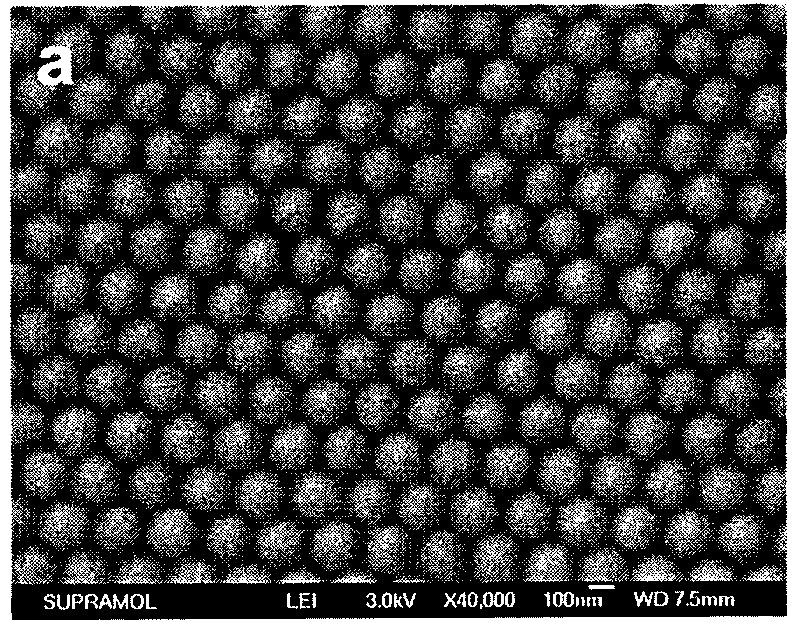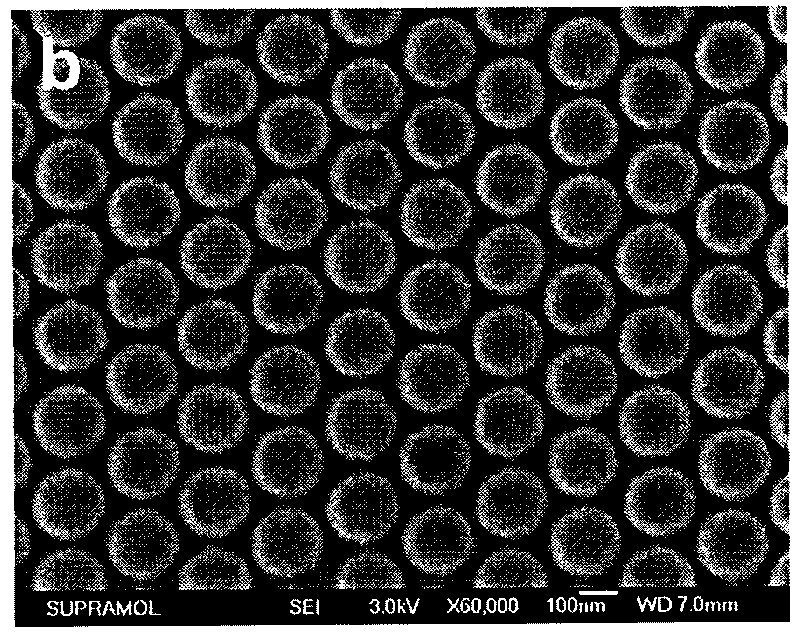Process for preparing silicon dioxide nano-cone array
A silicon dioxide and nanocone technology, applied in nanostructure manufacturing, nanotechnology, nanotechnology, etc., can solve the problems of expensive instruments, difficult to achieve large-area construction, and low efficiency.
- Summary
- Abstract
- Description
- Claims
- Application Information
AI Technical Summary
Problems solved by technology
Method used
Image
Examples
Embodiment 1
[0063] 1. The preparation method of polystyrene microspheres:
[0064] Under nitrogen protection, with 40 milliliters of absolute ethanol and 100 milliliters of deionized water as the dispersion medium, 3.3 milliliters of styrene, 0.0733 grams of potassium persulfate, and 0.0807 grams of sodium dodecylsulfonate were added to the In the reactor of the mechanical stirrer and the reflux condenser, the mechanical stirring speed was 350 rpm. The polymerization reaction was carried out in a water bath at 70° C., and after 10 hours of reaction, a stable milky white emulsion of monodisperse polystyrene microspheres was obtained, and the diameter of the microspheres was 210 nanometers.
[0065] 2. Preparation of polystyrene monolayer colloidal crystals:
[0066] The prepared polystyrene microspheres were centrifuged and washed, and then dispersed with a mixed solution of absolute ethanol and deionized water with a volume ratio of 1.5:1 to obtain a monodisperse polystyrene microsphere ...
Embodiment 2
[0070] 1. The preparation method of polystyrene microspheres and the preparation method of polystyrene monolayer colloidal crystals are shown in Example 1.
[0071] 2. Preparation of silica nanocone arrays:
[0072] Reactive ion etching of fluorine was carried out on the quartz substrate of the obtained surface-mounted polystyrene monolayer colloidal crystal, the etching power was RF 300W, the chamber pressure was 40mTorr, the flow rate of tetrafluoromethane was 30SCCM, and the flow rate of argon gas was 20SCCM , the etching time was 4 minutes, and then the remaining polystyrene was removed with chloroform to obtain a silica nanocone array with a period of 210 nm, a height of 211 nm, and a bottom diameter of 196 nm, as shown in Figure 5.
Embodiment 3
[0074] 1. The preparation method of polystyrene microspheres and the preparation method of polystyrene monolayer colloidal crystals are shown in Example 1.
[0075] 2. Preparation of silica nanocone arrays:
[0076]Reactive ion etching of fluorine was carried out on the quartz substrate of the obtained surface-mounted polystyrene monolayer colloidal crystal, the etching power was RF 300W, the chamber pressure was 40mTorr, the flow rate of tetrafluoromethane was 30SCCM, and the flow rate of argon gas was 20SCCM , the etching time was 3 minutes, and then the remaining polystyrene was removed with chloroform to obtain a silica nanocone array with a period of 210 nm, a height of 190 nm, and a bottom diameter of 201 nm, as shown in Figure 6.
PUM
| Property | Measurement | Unit |
|---|---|---|
| Diameter | aaaaa | aaaaa |
| Thickness | aaaaa | aaaaa |
| Bottom diameter | aaaaa | aaaaa |
Abstract
Description
Claims
Application Information
 Login to View More
Login to View More - R&D
- Intellectual Property
- Life Sciences
- Materials
- Tech Scout
- Unparalleled Data Quality
- Higher Quality Content
- 60% Fewer Hallucinations
Browse by: Latest US Patents, China's latest patents, Technical Efficacy Thesaurus, Application Domain, Technology Topic, Popular Technical Reports.
© 2025 PatSnap. All rights reserved.Legal|Privacy policy|Modern Slavery Act Transparency Statement|Sitemap|About US| Contact US: help@patsnap.com



